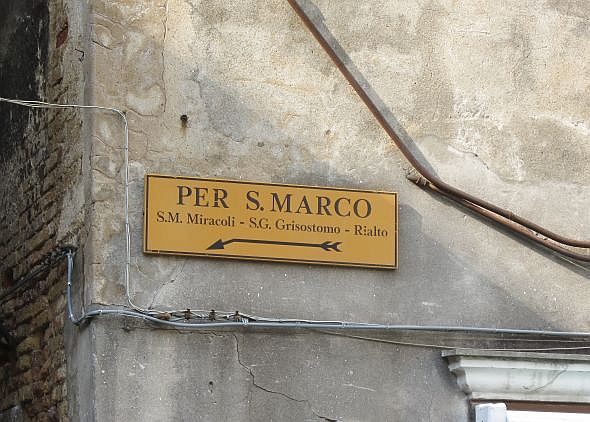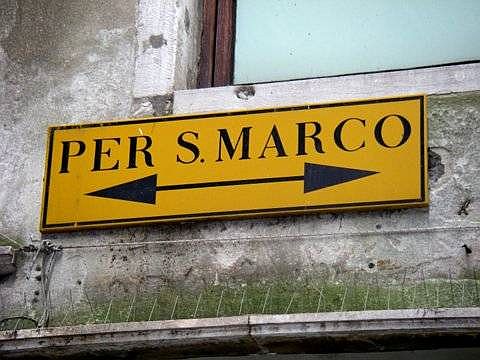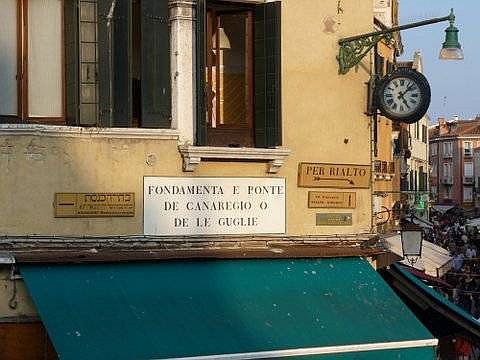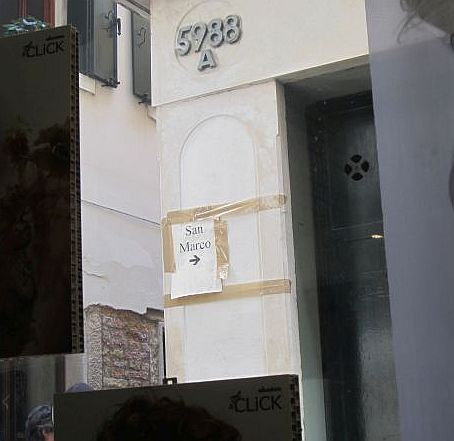
Everyone has been so busy recently dealing with the nizioleti and washing and bleaching and ironing them, so to speak, that there hasn’t been much time to worry about anything else.
But now that we’re looking at the walls, we can see that something is going on that’s almost as disconcerting as the rewriting of the bedsheets.
It has to do with the yellow signs attached to assorted walls around the city whose arrows indicate the right direction to take in order to reach the major points of interest: San Marco, Rialto, Accademia, and a few other points near and far. There aren’t enough of these signs, and they’re not always positioned at the really necessary spot, though admittedly the intentions are good. But that isn’t the problem.
Unlike the nizioleti, which were in danger of being un-Venetianized, their yellow cousins represent a bureaucratic convolution which is much knottier than whether to use double or single consonants. And these yellow cousins don’t even have a cute nickname, unless you want to call them “mystery” (giallo, in Italian — the same word as yellow).
The problem is that they too need therapy — to be repaired, cleaned up, made uniform throughout the city, and generally titivated. But they have no parents, no guardian, no adult supervision. Nobody is responsible for them. Nobody even knows who put them up, or when.

This more than usual strangeness came to light when a merchant wrote to the city to complain about another merchant who had made a little personal project of blacking out the words on certain normal signs, and installing a new yellow sign — example: “Per Rialto” — with an arrow pointing in the direction of his shop. This had been going on for six years, which I think demonstrates an amazing forbearance on the part of his competitors.
There’s a saying which describes this kind of behavior: “The devil makes the pots, but he doesn’t make their lids.” Which is to say that something skulduggerous might very well succeed up to a certain point, but it cannot remain concealed forever. You may be cooking along at a great rate on some sketchy project, but it will boil over, dry up and burn, catch fire, develop botulinum toxin, or otherwise eventually be discovered.
However, when the annoyed merchant wrote to ask the city to intervene to correct this delinquency, the city did not reply with the traditional comment no ghe xe schei.
Instead, the particular department (Urban Maintenance) informed him that “The Department of Public Works doesn’t install the yellow signs, and they don’t conform to the current regulations. In all of the Historic Center a signage indicating the most usual touristic routes are the object of continuous variations and tampering. It is impossible to determine the pre-existence, provenance, or eventual proprietors of these signs.
“Whatever intervention,” the reply continued, “requested by citizens or commercial operators for maintenance, cleaning up, renovation, or new installation, can only be made after a decision shared by the assessori (councilors) of Public Works, Commerce, Tourism, and Productive Activity” (the same thing as commerce, but different).
To sum up: We don’t know whose they are, but they’re not legal. We don’t know who put them there, but you can’t touch them. These are deep waters, Watson.

But Alessandro Maggioni, the assessore of Public Works, wanted to clarify the situation. “All of the public signage belongs to the administration, that’s a certainty,” he said, showing admirable pluck. “If there is damage, the Public Works substitutes the individual signs, but it’s true that to touch their indications we have to have the approval of the relevant department, that is, Tourism, and I know that for a while now they’ve been proceeding with a project of reorganization of the old signage of the city.”
After the epic adventure with the nizioleti, I am waiting with my follicles tingling to see what this might turn out to mean.
Meanwhile, follow the arrows with more than your usual caution. That, or just don’t buy anything along the way.
That’ll show everybody you’re not to be trifled with.

